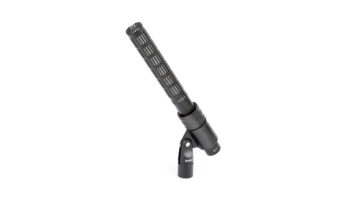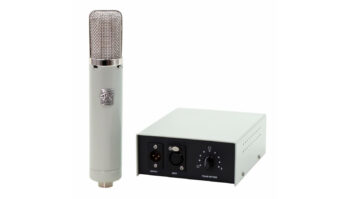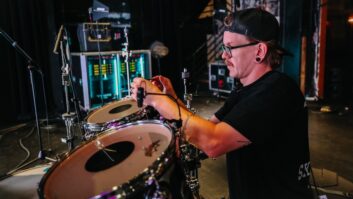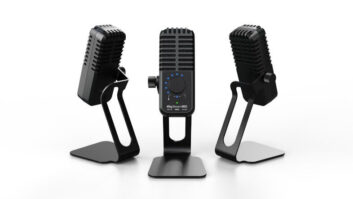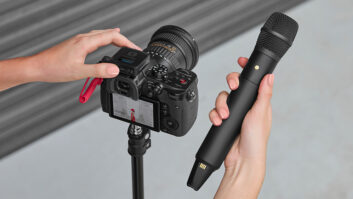AKG’s floor mounted GN155 gooseneck stand mates with a variety of miniature mic elements. Even in these days when it seems everything but the human voice has a “direct out,” the primary method for capturing sound for recording and amplification is still the microphone—but with so many types and options, how does one decide which mic to use for which application?

First and foremost should be the sound of the mic, but there are many other factors that come into play when picking the right mic for the job; these include mic size, pickup pattern, visibility, ruggedness, proximity to other sources and overall volume level on stage.
Point Source Audio CO-3 Earset Mic W/Dual-Ear Clip There are three broad categories of commonly used mics which are determined by the capsule (pickup element), not to be confused with the microphone body design (handheld, pencil, lavalier, headworn and so on) which is what most people recognize. Dynamic mics, which are frequently cardioid, are mainstays for HOWs due to their ruggedness and affordability. The Shure SM57 and 58, for instance, are dynamic mics. They are handheld and are comparatively less susceptible to feedback from stage monitors due to their directionality (cardioid), allowing greater gain before feedback. Condenser mics tend to be more sensitive and will pick up more sound and more details, making them ideal for choir and ensemble miking along with many instruments, but also making them more prone to plosives, or low-frequency thumps that come from users standing close and saying or singing words with P or B sounds. Common condensers are AKG’s C414 and C451, and Shure’s SM87. Ribbon mics, another type of dynamic mic, have lower electrical sensitivity, meaning that they produce a lower output, requiring more amplification (turn the gain up higher). That means they may reveal limitations in the signal chain: they are inherently figure-of-eight, meaning they pick up in the front and back of the microphone and nothing at all on the sides, which can be very useful.

Speaking of pickup patterns, there are many different options but the most common are omni, cardioid and bi-directional. Omni means the mic will pick up sound equally from all directions. Cardioid means it picks up from in front of the mic, picking up less on the sides and, ideally, very little from behind the mic. There are other variations on these basic patterns: wide cardioid, hyper and supercardioid, shotgun, etc.
If miking a small ensemble that will be standing around one (or two) mics, an omni or wide cardioid condenser mic will allow more people of the ensemble to be heard. It offers a wider pickup pattern and greater sensitivity, meaning the singers/players can spread out and not stand so close to the mic. The tradeoff is that it may also pick up some of the sound from the house and/or monitor loudspeakers. If a cardioid dynamic mic is used for this application, frequently only the person(s) standing directly in front of the mic will be heard. When miking a solo singer who is holding the mic, then a cardioid dynamic is likely the best choice. It will typically offer great directionality, will pick up fewer off-axis sources and will probably be less prone to handling noise. A ribbon mic can be ideally used in a situation where the preferred sound is next to other loud sources which don’t need to be amplified. One example is miking hand percussion next to drums or a choir.
Sennheiser’s D9000 flagship digital mic system elements (right) and Audio-Technica’s Artist Elite 5000 Series conventional wireless system (below)Podium Miking
For speakers and pastors, the typical podium mic can be improved many ways. Using a directional, gooseneck-mounted condenser mic such as those by Shure, Audio-Technica, Audix or DPA, you can accomplish a clean look and excellent sound pickup. Other options are lapel or lavalier mics, which have the advantage of staying with a speaker that is prone to wandering off mic, but they can suffer from clothing noise or the voice pickup diminishing if the speaker turns his head away from the mic. An increasingly popular option is the headworn mic, with very nice ear-attached models available from Sennheiser, Mogan, Countryman, Point Source Audio and DPA that are nearly invisible at a distance. Combine these with a belt-mounted wireless transmitter for the best of all options for unobtrusive pickup and freedom for a presenter.


Wireless and Vocal Miking
In the early days of wireless transmitters, there were serious sonic compromises to be balanced against the advantage of cable-free operation. These days, with hybrid analog systems such as those from Lectrosonics, and with digital transmission systems, there is really no reason apart from expense to not use a wireless system. Small and inexpensive transmitter/ receiver combos for mics and instruments (bass, guitar) like new products from Shure, Sennheiser, Sony, beyerdynamic, Line 6, AKG and Audio-Technica offer amazing performance and adequate range for most venues.
DPA 4041 T Omnidirectional Tube Microphone The primary considerations when choosing a handheld mic are susceptibility to handling noise and plosives. Most handheld mics are designed with low frequency rolloffs (high pass filters) built in to minimize the audibility of such artifacts. Most singers will prefer a handheld mic to a headworn mic so they have control over their distance from the mic. Hopefully the singer is not one of those who move the mic in and out as if it is on a rubber band, using the distance from their mouth like the physical equivalent of a compressor. Even-more directional patterns like hypercardiod (Audix’s OM6 would be an example) are often used by vocalists for maximum rejection of unwanted sound.

Moving next to choral applications, condenser mics are the typical choice. Miniature hanging microphones can be permanently installed, small directional condensers that hang from rafters or the ceiling, like the Audio-Technica U853R. These come with small angled arms that point the mic toward the choir. They work well and are a huge hit with the video crew because they are nearly invisible on camera.
For situations where the mics cannot be permanently installed, for smaller ensembles (8-10 singers), a single-point stereo mic like the Rode NT-4 (XY stereo condenser) offers quick setup and excellent sound. For larger ensembles, a visually unobtrusive option is the AKG GN 155, a very thin rigid gooseneck with floor stand, which can be used with a variety of AKG capsules and preamps.
Shure MX418 Gooseneck mic Instrument Miking
For acoustic grand piano, one supremely easy option is the Earthworks Piano Mic System, which is a single unit that attaches inside the piano, right above the bridge, featuring two mics on a single bar. In addition to sounding good, it is virtually invisible and can be used with the lid up or down. I have used AKG 414s for years on acoustic piano and DPA 4041s are favorites as well, either as a spaced pair or on a stereo bar. These both require the lid up.

The drum kit is certainly the biggest miking challenge of any instrument. The easiest solution for kick drum is a Shure Beta 91 sitting on a pillow inside, no stand required. For kick drums with a hole, the Shure Beta 52, Audio-Technica ATM25 or Electro-Voice RE20 inside are favorites. For snare, there’s the Shure SM57 or Telefunken M80. On toms, Sennheiser 421 or Audio-Technica’s ATM25, and then AKG C451s or Audio-Technica AT4047s on overheads. For the hi-hat, I frequently use a C451. In situations where space is tight or turnaround times are fast, using tom and snare mics that have integrated clips that clamp onto the drum rims are major time savers. Among others, Audio-Technica and Audix offer complete drum miking kits that can save on shopping angst.
Earthwork’s PianoMic system

For acoustic guitars in live settings, especially on loud stages, using a direct out is really the best option. Then a mic is required, I prefer small diaphragm condensers typically, like a Neumann KM84 or Audio-Technica ATM450 or 4041.
For electric guitar, a mic directly in front of the speaker is a good solution for live sound. Choosing which specific mic and positioning it can drastically alter the sound. For the brightest sound, aim the mic at the center of the speaker. Moving off-axis from the center will lessen the highs. Positioning a cardioid mic close to the speaker will result in a low-frequency boost due to proximity effect.
For hand percussion and drums, like congas and djembes, ribbon mics will offer a very natural, full sound. For tinkly sounds, like wind chimes, triangle, orchestra bells, claves or mark tree, a condenser mic will offer the best interpretation of those transient sounds, so long as feedback is not an issue.
Audix’s OM6 hypercardioid handheld vocal mic

For solo instruments like violin, saxophone and trumpet, I can’t say enough good things about the DPA 4099 series mics. They are small, stay in place and are great sounding.
In churches, as in most venues, there are trade-offs between the best possible sound and other extenuating factors. I hope these tips will help you make the most of your possibilities.
More HOW miking info
audio-technica.com/cms/site/eeb676eed005b1fb/index.html
audixusa.com/docs_12/about/videos_how_to_mic_a_choir.shtml
dpamicrophones.com/en/Microphone-University/point-sourceaudio.com/housesofworship.html
cdn.shure.com/publication/upload/399/us_pro_audiohousesworship_ea.pdf
HOW microphone advice from Audix end-user Kent Morris: /article/how-mic-selection/17119

